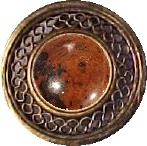
 |
Volcano Info |
Volcano Dictionary |
Volcano Activities and Printouts |
|
| Types of Volcanoes | The Ring of Fire | ||
| A | B | C | D | E | F | G | H | I | J | K | L | M | N | O | P | Q | R | S | T | U | V | W | X | Y | Z |
ocean An ocean is a vast body of salt water. Oceans cover more than three-quarters of the surface of the Earth. The oceans on Earth include the Pacific Ocean, the Atlantic Ocean, the Indian Ocean, and the Arctic Ocean. The ocean floors are composed mostly of basalt. |
 obsidian Obsidian (also called Apache tears) is a volcanic glass that is usually black, but is occasionally red, brown, gray, green (rare), dark with "snowflakes," or even clear. This glassy, lustrous mineral is found in lava flows, and obsidian stones can be massive. Obsidian is formed when viscous lava (from volcanos) cools rapidly. Most obsidian is 70 percent silica. Obsidian has a hardness of 5 and a specific gravity of 2.35. The pin above is mahogany (brown) obsidian. |
oceanic plates The crust of the Earth is broken into plates. The plates are enormous chunks of rock that float atop the soft mantle. The plates are moving at a speed that has been estimated at 1 to 10 cm per year. Oceanic plates (those that are under the ocean) are thinner, younger, and denser than continental plates. These underwater plates are about 75 kilometers thick and are made of basalt rock. They are relatively young since plate formation (seafloor spreading) occurs at the margins of oceanic plates. |
oceanography Oceanography is the science that studies the physical geography of oceans. |
outcrop An outcrop is a place where bedrock is visible on the surface of the Earth. |
outgassing Outgassing is the release of gases into the atmosphere during volcanic eruptions. A lot of of our atmosphere (including water vapor, nitrogen, and argon) came from outgassing. |
ozone Ozone is a form of oxygen (O3); it consists of three connected oxygen atoms. Ozone is formed when oxygen molecules (O2) bonds are broken by high energy (bombardment by energetic electrons or high energy radiation). |
ozone layer The ozone layer is a region of the stratosphere which contains most (about 90%) of the Earth's atmospheric ozone. It is about10-25 miles (15-40 km) above the Earth's surface. The ozone layer shields the Earth from Ultraviolet B rays that come from the Sun. The ozone layer is becoming depleted, and there is an "ozone hole" over Antarctica. |
Volcano Info |
Volcano |
Volcano Activities and Printouts |
|
| Types of Volcanoes | The Ring of Fire | ||
| A | B | C | D | E | F | G | H | I | J | K | L | M | N | O | P | Q | R | S | T | U | V | W | X | Y | Z |
Enchanted Learning®
Over 35,000 Web Pages
Sample Pages for Prospective Subscribers, or click below
|
Overview of Site What's New Enchanted Learning Home Monthly Activity Calendar Books to Print Site Index K-3 Crafts K-3 Themes Little Explorers Picture dictionary PreK/K Activities Rebus Rhymes Stories Writing Cloze Activities Essay Topics Newspaper Writing Activities Parts of Speech Fiction The Test of Time
|
Biology Animal Printouts Biology Label Printouts Biomes Birds Butterflies Dinosaurs Food Chain Human Anatomy Mammals Plants Rainforests Sharks Whales Physical Sciences: K-12 Astronomy The Earth Geology Hurricanes Landforms Oceans Tsunami Volcano |
Languages Dutch French German Italian Japanese (Romaji) Portuguese Spanish Swedish Geography/History Explorers Flags Geography Inventors US History Other Topics Art and Artists Calendars College Finder Crafts Graphic Organizers Label Me! Printouts Math Music Word Wheels |
Click to read our Privacy Policy
| Search the Enchanted Learning website for: |